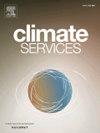Assessing the local context for implementing a climate based early warning system for dengue fever outbreaks in Ecuador
IF 4
3区 环境科学与生态学
Q2 ENVIRONMENTAL SCIENCES
引用次数: 0
Abstract
Dengue fever is hyper-endemic in Ecuador and has persistently challenged its public health system. Previously, El Niño Southern Oscillation (ENSO) and its impact on local temperature and precipitation in coastal Ecuador was linked to dengue outbreaks. A framework for early epidemics prediction based on long-lead ENSO and local climate forecasts was developed and tested for El Oro province. It could provide timely information to policy makers, but it is not being systematically utilized. In this study we assess barriers and pathways for a climate-driven dengue EWS implementation in Ecuador. Initially, 30 stakeholders from the climate and health sector were approached, and 11 semi-structured interviews were conducted and analyzed using the Consolidated Framework for Implementation Research to identify needs and priorities. Although all topics were covered during each interview, the structure and sequence of the questions varied according to the stakeholder background. In the exploratory phase specific codes were assigned to data fragments, and themes that reached the highest level of saturation were analyzed. Our results point to a limited compatibility between the current outbreak management and a climate-driven dengue EWS. To enhance compatibility, all participants indicated that EWS implementation should be led by the Ministry of Health or another established inter-institutional management structure invested with authority and knowledge about the needs and aims. This would ensure the participation of stakeholders with diverse backgrounds, and build trust in the EWS. Promoting data sharing, working on city or province level and improving local infrastructure to prevent flooding could also guarantee its effectiveness.
评估在厄瓜多尔实施基于气候的登革热疫情预警系统的当地情况
登革热在厄瓜多尔高度流行,并一直对其公共卫生系统构成挑战。以前,厄尔Niño南方涛动(ENSO)及其对厄瓜多尔沿海地区当地温度和降水的影响与登革热疫情有关。基于长期ENSO和当地气候预报的早期流行病预测框架已在埃尔奥罗省制定并进行了测试。它可以向决策者提供及时的信息,但没有得到系统的利用。在本研究中,我们评估了气候驱动型登革热EWS在厄瓜多尔实施的障碍和途径。最初,与气候和卫生部门的30个利益攸关方进行了接触,进行了11次半结构化访谈,并使用《实施研究综合框架》进行了分析,以确定需求和优先事项。尽管在每次访谈中涵盖了所有主题,但问题的结构和顺序根据利益相关者的背景而有所不同。在探索阶段,将特定代码分配给数据片段,并分析达到最高饱和度的主题。我们的研究结果表明,当前的疫情管理与气候驱动的登革热EWS之间的兼容性有限。为了加强兼容性,所有与会者都表示,卫生保健系统的实施应由卫生部或对需求和目标具有权威和知识的另一个既定机构间管理结构领导。这将确保具有不同背景的利益相关者的参与,并建立对EWS的信任。促进数据共享,在城市或省一级开展工作,改善当地基础设施以防止洪水,也可以保证其有效性。
本文章由计算机程序翻译,如有差异,请以英文原文为准。
求助全文
约1分钟内获得全文
求助全文
来源期刊

Climate Services
Multiple-
CiteScore
5.30
自引率
15.60%
发文量
62
期刊介绍:
The journal Climate Services publishes research with a focus on science-based and user-specific climate information underpinning climate services, ultimately to assist society to adapt to climate change. Climate Services brings science and practice closer together. The journal addresses both researchers in the field of climate service research, and stakeholders and practitioners interested in or already applying climate services. It serves as a means of communication, dialogue and exchange between researchers and stakeholders. Climate services pioneers novel research areas that directly refer to how climate information can be applied in methodologies and tools for adaptation to climate change. It publishes best practice examples, case studies as well as theories, methods and data analysis with a clear connection to climate services. The focus of the published work is often multi-disciplinary, case-specific, tailored to specific sectors and strongly application-oriented. To offer a suitable outlet for such studies, Climate Services journal introduced a new section in the research article type. The research article contains a classical scientific part as well as a section with easily understandable practical implications for policy makers and practitioners. The journal''s focus is on the use and usability of climate information for adaptation purposes underpinning climate services.
 求助内容:
求助内容: 应助结果提醒方式:
应助结果提醒方式:


